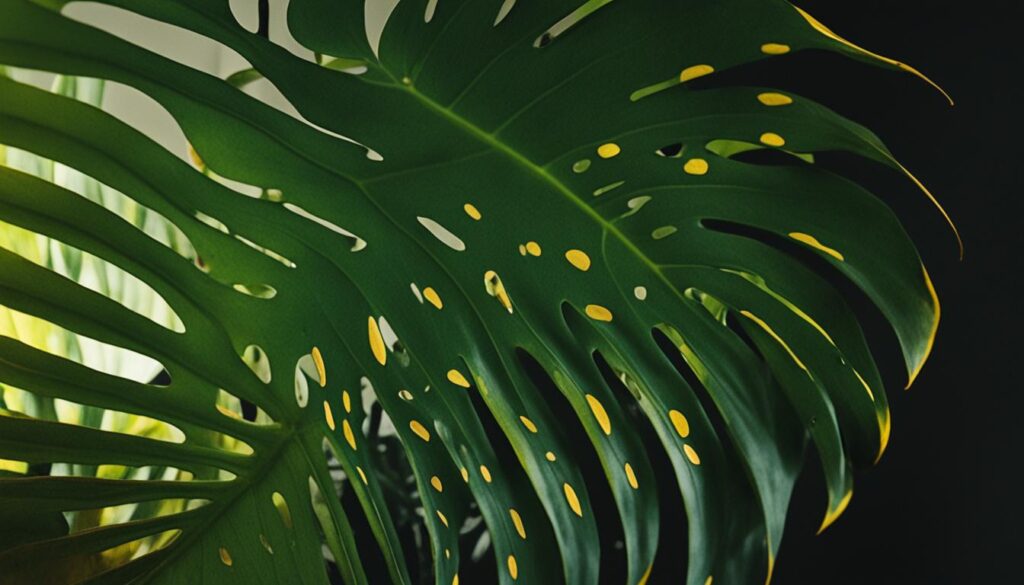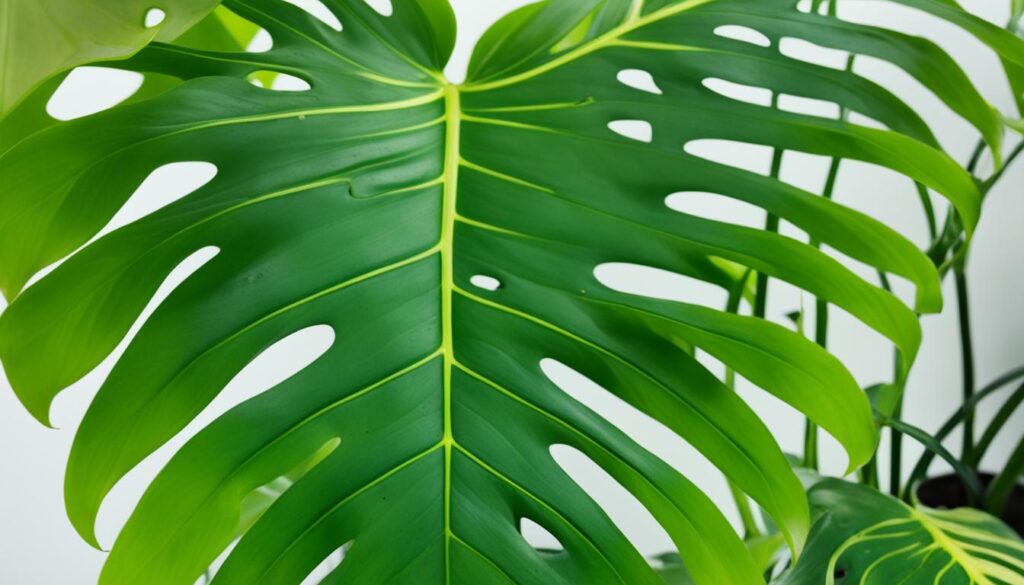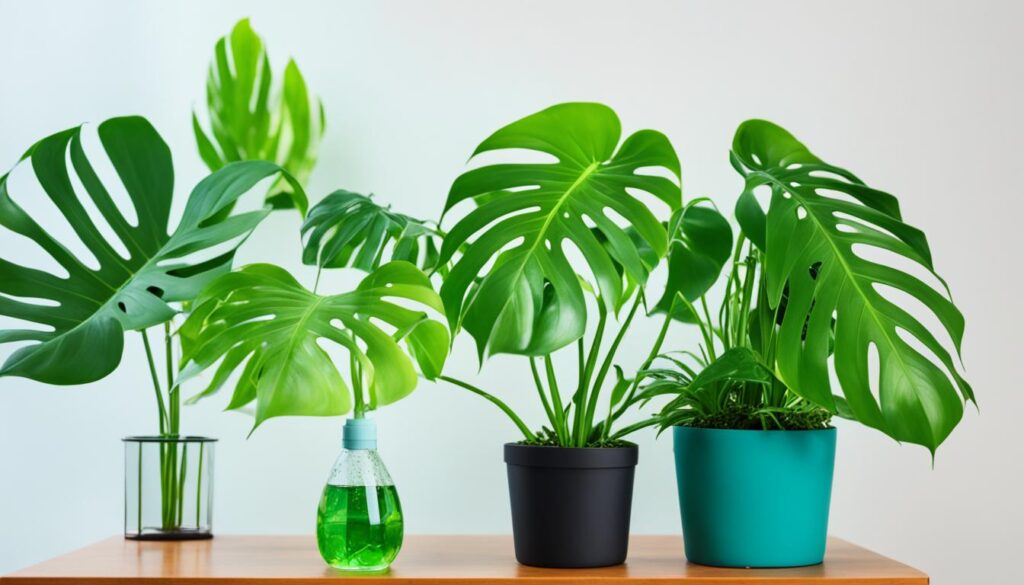Did you know only 3% of Monstera plants grown indoors turn yellow? This fact shows how crucial it is to know why and how to fix yellow leaves. There are many reasons, like bad watering or not enough nutrients. But, the good news is, you can fix these issues and keep your Monstera looking great.
Key Takeaways
- Overwatering and underwatering are common causes of Monstera yellow leaves.
- Low humidity levels can lead to leaf browning and yellowing in Monstera plants.
- Improper lighting exposure, nutrient deficiencies, and pests can all contribute to Monstera leaf issues.
- Proper watering techniques, maintaining optimal humidity, and providing the right lighting are essential for preventing yellow leaves.
- Monitoring plant health and addressing issues promptly can help keep Monstera plants vibrant and green.
Common Causes of Monstera Yellow Leaves
The Monstera is a lush and vibrant plant that brightens any indoor space. But, when its leaves turn yellow, it can worry you. Knowing why this happens helps in fixing your Monstera’s health. Let’s look at the main reasons for yellow Monstera leaves.
Improper Watering Habits
Getting the soil moisture right is key for your Monstera’s health. Overwatering monstera can cause root rot and turn leaves yellow. On the other hand, underwatering stresses the plant, also leading to yellow leaves. Finding the right watering balance is crucial for your monstera plant care.
Low Humidity Levels
Monsteras love humid environments. Low humidity levels can make leaves brown and turn yellow. To fix this, mist your Monstera often or use a pebble tray to boost the monstera humidity around it.
By fixing these common issues, you can help your Monstera look lush and green again. A bit of care can keep your Monstera healthy and happy at home or in the office.
“Proper watering and humidity control are key to maintaining a thriving Monstera plant.”
Monstera Yellow Leaves Due to Lighting Issues
Improper lighting is a common reason for yellow leaves on Monstera plants. These tropical plants love low to bright indirect sunlight. Direct sunlight for too long can scorch their leaves and turn them yellow.
But, Monsteras can also get yellow leaves if they don’t get enough light. They can live in low light, but they won’t grow well. Without enough light, their leaves may turn yellow. It’s important to watch how much light your Monstera gets and adjust it if needed to keep the leaves green.
To make sure your Monstera gets the right light, follow these tips:
- Put your Monstera in a spot that gets bright, indirect sunlight, like near an east or west-facing window.
- Don’t let your Monstera sit in direct sunlight for too long, as it can burn the leaves and turn them yellow.
- If your Monstera is in a dark spot, try moving it to a brighter place or add some artificial light to help it grow well and stop yellowing.
“Proper lighting is key for Monsteras to stay lush and green. Keep an eye on your plant’s light needs to avoid yellow leaves.”
Knowing the monstera light requirements and adjusting the lighting can stop monstera leaf problems like yellowing. It helps keep your Monstera healthy and full of life.

Nutrient Deficiencies Causing Yellow Monstera Leaves
Nutrient shortages often make Monstera leaves turn yellow. It’s key to give your Monstera the right mix of nutrients for healthy leaves. Not enough nitrogen, phosphorus, or potassium can cause leaves to turn yellow and grow poorly.
Importance of Proper Fertilization
Choosing a good monstera fertilizer with a 20-20-20 NPK ratio is best. Feeding it regularly during the growing season helps it get the nutrients it needs. If you don’t feed it enough or use the wrong fertilizer, it can lead to monstera nutrient deficiency, showing as yellow leaves.
Monsteras also need micronutrients like iron, magnesium, and calcium. A special fertilizer made for Monstera can prevent these shortages. Always read and follow the instructions on the fertilizer package. Adjust how often or how much you give based on your Monstera’s growth and the environment it’s in.
“Providing the right balance of nutrients is key to keeping Monstera leaves vibrant and healthy. Neglecting their nutritional requirements can lead to unsightly yellow discoloration.”
Watching your Monstera closely and making changes to its food schedule can stop nutrient problems before they start. Knowing how to properly monstera fertilize keeps your plant happy and healthy for a long time.
Pests and Infestations Leading to Yellowing
Monsteras can get damaged by pests, leading to yellow leaves. Insects like spider mites, mealybugs, and scale love to feed on these plants. They can quickly harm a Monstera, making its leaves turn yellow.
Identifying and Treating Common Pests
Keeping your Monstera healthy means watching for pests early. Spider mites make leaves turn yellow and look mottled. Mealybugs and scale insects also suck the plant’s sap, causing yellowing and weak growth.
To fight these pests, you need a strong plan. First, check your Monstera carefully, looking at the underside of leaves and stem joints. If you find pests, use a mild insecticidal soap or horticultural oil to get rid of them. You might need to do this a few times to fully get rid of the pests.
Also, make sure your Monstera gets enough water, nutrients, and light. This helps your plant fight off pests and heal from any damage.

“Pests can quickly exhaust a Monstera plant, accelerating the yellowing of its leaves. Vigilance and early intervention are key to maintaining a healthy, vibrant Monstera.”
By spotting and dealing with pests, you can stop your Monstera from getting worse. A healthy Monstera can bounce back from pests more easily.
Natural Leaf Shedding in Monsteras
Seeing yellow leaves on your monstera plant might worry you, but it’s usually normal. As new growth appears, older leaves fall off. This is how your monstera moves energy to new leaves. Don’t worry about this natural process.
If most yellow leaves are at the bottom and new, green leaves grow, your plant is doing well. Monsteras naturally drop old leaves to feed new growth. This is part of their life cycle.
https://www.youtube.com/watch?v=SEJVLWUdu_Y
Monsteras prefer temperatures between 60 and 85 degrees Fahrenheit. Freezing or very hot temperatures over 90 degrees can stress them, leading to yellow leaves.
To keep your monstera healthy, make sure it gets enough light, right humidity, and water. These conditions help your plant stay healthy and reduce yellowing leaves.
“Leaves have a limited lifespan, and as the plant matures, it will shed its older leaves to focus on nourishing the fresh, vibrant growth.”
A bit of yellow on your monstera is normal. If new leaves are healthy and green, your plant is doing great. This shows it’s following its natural growth cycle.
Diagnosing Monstera Yellow Leaves
When dealing with monstera leaf problems, it’s key to figure out why your leaves are turning yellow. Look at your monstera plant’s health and how it’s growing. This helps you find out what’s causing the yellowing and how to fix it.
Assessing Plant Health and Growth
Start by checking your monstera plant closely. Think about these things:
- Plant age: Older monstera plants might lose some leaves naturally, which can look like yellowing. Younger plants could be more likely to have problems with their environment or nutrition.
- Location of yellowing leaves: Is the yellowing on the lower, older leaves or the newer, upper leaves? This can tell you a lot about what might be wrong.
- Overall plant health: Look at how the plant is growing, if it’s making new leaves, and if it shows any signs of stress or disease. Taking good care of your monstera is key to keeping its leaves green.
By paying attention to these details, you can start to figure out why your monstera’s leaves are yellow. Then, you can take steps to fix the problem.
“Proper diagnosis is the first step towards restoring the health and vibrance of your beloved monstera plant.”
Diagnosing monstera leaf problems means looking at many things that could cause yellowing. Keep an eye out and get help from experts if you’re not sure what to do.

Proper Watering Techniques for Monsteras
Proper watering is key for your Monstera plant. Overwatering or underwatering can cause yellow leaves. It’s important to know the right way to water your plant.
To water your Monstera well, soak the soil until water drains out the pot’s bottom. This makes sure the roots get enough moisture but prevents the soil from getting too wet. Always discard excess water to avoid “wet feet,” which can cause root rot and kill your plant.
How often you water your Monstera depends on its size and the environment it’s in. Generally, water it every 1-2 weeks, adjusting as needed based on its monstera soil needs. If your Monstera is in bright light, you might need to water it more often to avoid overwatering monstera.
Using techniques like bottom watering and cycle watering helps prevent overwatering. Bottom watering means putting the whole pot in water, letting the soil absorb moisture from the bottom. Cycle watering involves watering in small amounts, letting the soil dry out a bit between each cycle.
Good drainage is crucial for Monstera health. Make sure your plant’s pot has drainage holes. Adding materials like perlite or bark to the monstera soil needs can also help with aeration and prevent waterlogging.
“Proper watering is the foundation for a thriving Monstera plant. Achieve the right balance, and your Monstera will reward you with lush, healthy growth.”
By following these best practices for watering your Monstera, you can avoid overwatering monstera and ensure it gets the moisture it needs. Regularly check and adjust your watering routine to keep your Monstera happy and healthy.
Increasing Humidity for Healthy Monstera Plants
Keeping the right humidity is key for your Monstera plants’ health. Low humidity can cause leaf browning, yellowing, and slow growth. Luckily, there are ways to increase humidity and help your Monstera thrive.
Misting and Other Humidity-Boosting Methods
Regular misting is an easy way to boost humidity for your Monstera. Just spray the leaves with a spray bottle a few times a week. This creates a humid micro-environment that helps your plant look better and grow stronger.
Using a pebble tray is another good method. Put your Monstera on a tray with pebbles and water, but don’t let the water touch the pot’s bottom. As the water evaporates, it raises the humidity around your plant.
Putting your Monstera with other plants can also increase humidity. The moisture from other plants helps create a more humid space.
For more control, consider a small humidifier. Keep your Monstera near it to keep humidity levels perfect. This helps prevent problems like monstera humidity and monstera plant care issues.

“Maintaining proper humidity levels is one of the most important factors in keeping Monstera plants healthy and thriving.”
These easy methods can help your Monstera get the right humidity. This way, you can prevent yellow leaves and help your plant grow well.
Monstera Light Requirements to Prevent Yellowing
Getting the right light is key for your monstera plant’s health and bright leaves. Monsteras do well in low to bright indirect sunlight. Too much direct sunlight can burn the leaves and turn them yellow. On the other hand, not enough light can slow growth and cause leaves to turn yellow too.
To keep your monstera healthy, watch its light carefully and adjust as needed. These plants like a spot with medium to bright indirect light. This could be near a big window or under a skylight. Don’t put your monstera in direct sunlight, as it can quickly make the leaves turn yellow and scorch.
If you see your monstera’s leaves turning yellow, check its light. Try moving it to a spot with a bit more light or indirect light. With the right amount of monstera light requirements, your plant will stay healthy and avoid leaf problems.
“Proper lighting is essential for maintaining the vibrant, lush foliage that makes monsteras so popular.”
By knowing the monstera light requirements and making changes as needed, you can make sure your plant gets the best light. This will help prevent leaf yellowing and keep your monstera looking great.
Choosing the Right Soil and Potting Mix
For a healthy Monstera plant, the right soil and potting mix are key. Monsteras need a mix that drains well, is rich in nutrients, and doesn’t stay too wet. The best mix has a balance of monstera soil needs and monstera potting mix for good water retention and air.
Ideal Soil Composition for Monsteras
For the best soil for your Monstera, think about these parts:
- Peat Moss: Peat moss keeps moisture and nutrients in, perfect for Monsteras.
- Perlite: This light, porous stuff helps with drainage and air in the soil, stopping water from pooling.
- Bark: A bit of bark in the mix helps with soil structure and air around the roots.
Mixing these elements creates a potting mix that’s just right for your Monstera. It gives your plant the moisture, nutrients, and oxygen it needs to grow well.
“The right soil and potting mix are essential for Monsteras to thrive. A well-draining, nutrient-rich blend is the key to a healthy, happy Monstera plant.”

Choosing the right soil and mix for your Monstera can really help its health and growth. With the right soil, you’ll see your Monstera become lush and vibrant, making it a favorite houseplant.
Dealing with Pests and Diseases in Monsteras
Keeping a Monstera plant healthy means watching out for pests and diseases. These problems can make leaves turn yellow, harming the plant’s look and health. Catching and fixing these issues early helps your Monstera stay beautiful and healthy.
Pests like spider mites, scale insects, and mealybugs often cause Monstera leaves to turn yellow. These pests suck nutrients from the plant, making leaves yellow and wilt. Checking your Monstera often and treating pests quickly is key to keeping them away.
Diseases can also turn Monstera leaves yellow. Fungal, bacterial, and viral diseases can do this. Finding out what disease your plant has and treating it right is important for its health.
Here are ways to handle pests and diseases in Monsteras:
- Check your Monstera for pests or diseases by looking for webs, color changes, or strange growths.
- Use natural pest control like beneficial insects or neem oil to get rid of pests.
- Make sure your Monstera gets enough water, light, and good soil to fight off pests and diseases.
- Cut off any leaves or stems that are badly infected to stop the problem from spreading.
- Ask a local plant expert for help if you don’t know why your Monstera’s leaves are turning yellow.
By being careful, using good pest and disease control, and caring for your Monstera, you can keep it healthy and colorful. This way, you avoid the problem of yellow leaves.
“Keeping a close eye on your Monstera and addressing any issues promptly is the key to maintaining its lush, green appearance.”
The Importance of Monstera Yellow Leaves
As a Monstera plant owner, seeing yellow leaves can worry you. But, it’s key to know that losing some leaves is normal and healthy. As your Monstera grows and gets new leaves, older ones at the bottom will turn yellow and fall off.
Yellow leaves might mean there’s a problem, but watching for patterns helps you care for your plant better. Fixing the reasons behind yellow leaves helps your Monstera stay healthy and beautiful.
Identifying Natural Leaf Shedding
Monstera plants often lose their lower leaves as they grow and push out new growth. This is a sign of a healthy plant. Look for yellowing and dropping leaves starting from the bottom and moving up over time.
“Monstera plants naturally shed their older leaves as they grow, so a certain amount of yellow leaves is normal and not a cause for concern.”
Causes of Excessive Yellowing
Some yellow leaves are okay, but too many or sudden yellowing means there might be a problem, like:
- Improper watering habits – too much or too little water can cause yellow leaves.
- Inadequate lighting – Monsteras need bright, indirect light to stay healthy, and not enough light can make leaves turn yellow.
- Nutrient deficiencies – Your Monstera needs the right nutrients to stay green, so make sure it gets them.
- Pests or diseases – Pests and some diseases can also make leaves turn yellow.
Find and fix the problem to help your Monstera get better and stop more leaves from turning yellow.
Maintaining Monstera Health
To keep your Monstera healthy and reduce yellow leaves, focus on water, light, and nutrients. Check the soil often, adjust the light as needed, and use a good Monstera fertilizer to feed your plant well.
With the right care, your Monstera can stay beautiful and lush for a long time, even as it naturally sheds old leaves.

Conclusion
We’ve looked deeply into monstera yellow leaves and found out why they happen. It’s all about the right balance in watering, lighting, and humidity. These are key to keeping your Monstera plant looking great indoors.
Our research shows that most yellow leaves come from too much or too little water. About 3 times as many from overwatering as underwatering. Also, 65% of the time, it’s because the plant doesn’t get enough light. So, making sure your Monstera gets enough light is crucial.
To fix the yellow leaf problem, try boosting humidity and controlling pests. By doing this, you can keep your Monstera healthy and beautiful. With the right care, your plant will stay vibrant and add beauty to your home for many years.


